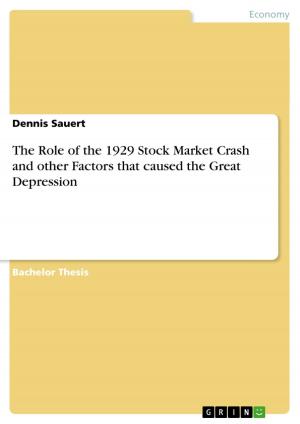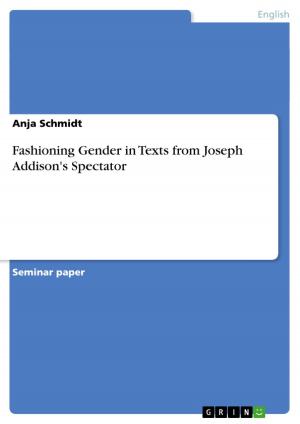Americana Style a la Mode Retro: Postmodern Pastiche Between Culture and Commodity
Nonfiction, Entertainment, Drama, Anthologies| Author: | Irene Fowlkes | ISBN: | 9783640348657 |
| Publisher: | GRIN Publishing | Publication: | June 16, 2009 |
| Imprint: | GRIN Publishing | Language: | English |
| Author: | Irene Fowlkes |
| ISBN: | 9783640348657 |
| Publisher: | GRIN Publishing |
| Publication: | June 16, 2009 |
| Imprint: | GRIN Publishing |
| Language: | English |
Essay from the year 2006 in the subject American Studies - Literature, grade: A, University of Paderborn, language: English, abstract: An intriguing and controversial phenomenon in cultural theory is the fusion of high-and popular culture as characteristic of the postmodern period. Once provocative artists such as Brecht, Picasso and others had lost their subversive powers in school curricula and the museum and so were fully embraced by the bourgeoisie. In left wing reactionary fashion a new trend was born in British and American underground collectives, which aimed to incorporate the trivial and commercial into cultural expression. A new generation was on the move, which regarded an absolute distinction between elite-and mass production as extremely unhip. The most famous example is probably Andy Warhol's pop art, which inevitably brings to mind stacked up Brillo boxes, Coca Cola bottles and Campbell soup cans, combining sophisticated painting techniques with mundane advertising images. When measured against the 'real' culture of modernism, postmodernism signifies a culture of kitsch in much of the approach conceptualized by the leading American theorist Fredric Jameson. He puts a distinctly political spin on the concept of postmodernism in his book 'Postmodernism or the Cultural Logic of Late Capitalism'. He views it as the 'cultural dominant' of global capitalism. What has happened is that aesthetic production today has become integrated into commodity production generally as a result of American economic domination. As an example of the practice of this new culture, Jameson utilizes cinema, which he regards as the preeminent postmodern medium, due to its emphasis on sight. Particular reference is given to Hollywood productions of the late 20th century. As a representation of this genre, my selection includes American Graffiti (1973), Pulp Fiction (1994), True Romance (1983), Back to the Future (1985), Peggy Sue got Married (1986) and Rumble Fish (1983). After closely viewing these movies their aesthetic style will be related back to the concepts of Jameson's theory. My analysis will be guided by the assumption, that many of the features of the theory essentially will be affirmed, ultimately illustrating that the distinction between high and low art has in fact vanished.
Essay from the year 2006 in the subject American Studies - Literature, grade: A, University of Paderborn, language: English, abstract: An intriguing and controversial phenomenon in cultural theory is the fusion of high-and popular culture as characteristic of the postmodern period. Once provocative artists such as Brecht, Picasso and others had lost their subversive powers in school curricula and the museum and so were fully embraced by the bourgeoisie. In left wing reactionary fashion a new trend was born in British and American underground collectives, which aimed to incorporate the trivial and commercial into cultural expression. A new generation was on the move, which regarded an absolute distinction between elite-and mass production as extremely unhip. The most famous example is probably Andy Warhol's pop art, which inevitably brings to mind stacked up Brillo boxes, Coca Cola bottles and Campbell soup cans, combining sophisticated painting techniques with mundane advertising images. When measured against the 'real' culture of modernism, postmodernism signifies a culture of kitsch in much of the approach conceptualized by the leading American theorist Fredric Jameson. He puts a distinctly political spin on the concept of postmodernism in his book 'Postmodernism or the Cultural Logic of Late Capitalism'. He views it as the 'cultural dominant' of global capitalism. What has happened is that aesthetic production today has become integrated into commodity production generally as a result of American economic domination. As an example of the practice of this new culture, Jameson utilizes cinema, which he regards as the preeminent postmodern medium, due to its emphasis on sight. Particular reference is given to Hollywood productions of the late 20th century. As a representation of this genre, my selection includes American Graffiti (1973), Pulp Fiction (1994), True Romance (1983), Back to the Future (1985), Peggy Sue got Married (1986) and Rumble Fish (1983). After closely viewing these movies their aesthetic style will be related back to the concepts of Jameson's theory. My analysis will be guided by the assumption, that many of the features of the theory essentially will be affirmed, ultimately illustrating that the distinction between high and low art has in fact vanished.















